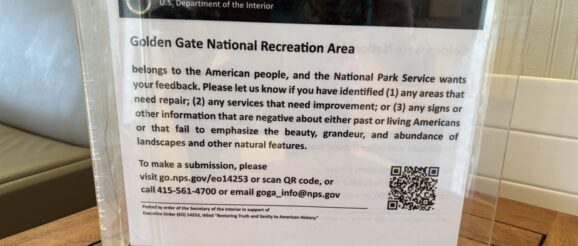National Park visitors opt not to flag signs with ‘negative’ information

Visitors to the Presidio of San Francisco, a National Historic Landmark and former military garrison with a complex history seemed unimpressed by the small black-and-white sign placed on a coffee table at roughly shin-level near the Presidio’s welcome center on a recent morning.

“The point of going to a park is to enjoy nature, not to whistleblow something that casts the American people in a bad light,” said Evan Sutterfield, a San Francisco school teacher enjoying a day out on his summer break.
“I think you need to tell the whole story,” said Russ Harwell, visiting from Charlotte, N.C. “If you’re gonna write it out of history, then you’re doomed to repeat it.”
‘Restoring Truth and Sanity to American History’
The signs, which invite people to send comments anonymously using a QR code, phone number, email or web address, have appeared in response to an executive order President Trump issued in March titled “Restoring Truth and Sanity to American History.” It specifically calls for the removal of content from monuments and properties within the Department of the Interior that “inappropriately disparages Americans past or living.”

None of the submitted comments suggest the parks need to change their depictions of people or history.
Some are supportive. “The park rangers and volunteers go above and beyond to tell the full American story,” stated a comment about Catoctin Mountain Park in Maryland.
Others say national parks should reflect even more of the country’s difficult history. “Need more history on how black and indigenous people have been exploited,” one comment stated.
Differing opinions
That’s not to say all visitors are happy about the historical information shared at parks.
Department of the Interior spokesperson J. Elizabeth Peace said after Trump issued the executive order — but before the signs went up — her department had already started receiving feedback from national park visitors via the department’s email address.
Peace said one example relates to Capitol Reef National Park in Utah, where a visitor reported that a souvenir postcard mislabeled a nearby landmark and appeared to copy text from Wikipedia without attribution.
Another came from a visitor concerned about a video on the website of the Washington Monument in Washington, D.C., which inaccurately stated George Washington ended his inaugural oath with a phrase historians widely agree lacks definitive sourcing.

The phrase in question was “So help me God.”
Neither of these comments related to Trump’s executive order about content that, “inappropriately disparages Americans past or living.” But Peace said they were nevertheless useful.
“Both examples provided were reviewed by the National Park Service and appropriate corrective or clarifying action was taken,” Peace said. “These examples underscore the value of public feedback in helping us maintain historical accuracy across our sites and materials.”
Accuracy challenges
Accuracy isn’t a given, because feedback can be submitted through a general website or email address accessible from anywhere in the world.
“What would stop somebody with an agenda from posting fake comments?” said Clara Wooden, a member of the board of The Coalition to Protect America’s National Parks. “People at both ends of the ideological spectrum can game the system without even setting foot in a national park.”
